The free-range milk from Tokachi Shinmura Farm in Hokkaidō offers a flavor experience like no other. Here, we visit the man behind it to investigate the secret behind this next-level milk.
Looking to the Soil
Shinmura Hirotaka is the fourth-generation head of Tokachi Shinmura Farm, located in Tokachi’s Kamishihoro district in Hokkaidō, and a passionate practitioner of free-range dairy farming.
“Originally, everyone around here pastured their cows,” explains Shinmura. “Then, back in my parents’ day, the soil started failing, and then the grass started failing, and the cows stopped eating it. So, lots of dairy farmers stopped pasturing their cattle and started keeping them in enclosures where they had to bring feed directly to the cows.”
The result was that the cows began to lead an almost mechanical existence, with feed put in and milk taken out. It was not what you could call a healthy condition. Naturally, that also led to a decline in the milk’s flavor. Shinmura says, “What they lacked at the time was science-based soil management.”
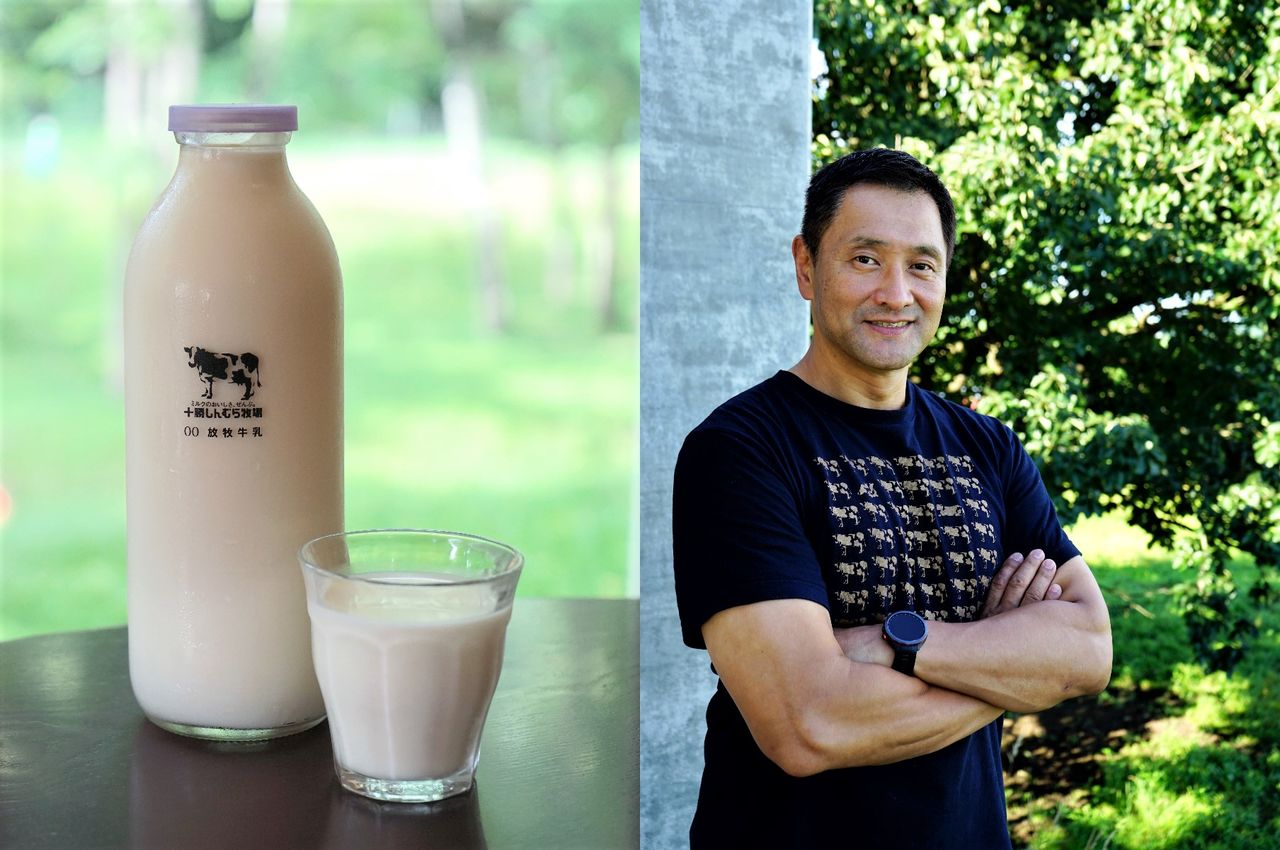
Left: The flavor of free-range milk is born from good soil. Right: Shinmura Hirotaka is a fan of Harley Davidson, rugby, and Armani. (© Ukita Yasuyuki)
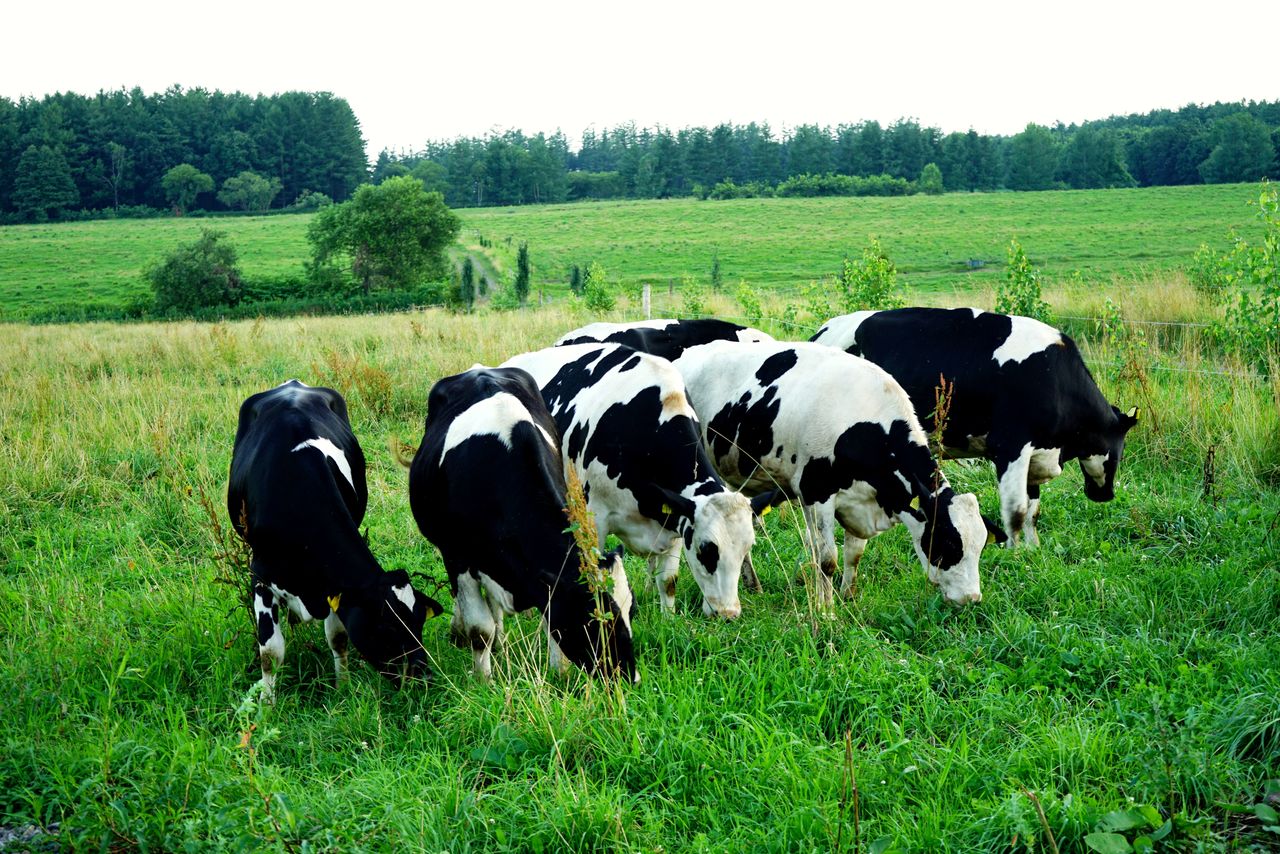
Most people think the sight of cattle out grazing in pastures is a typical one for Hokkaidō, but in fact only about 10% of dairy farmers pasture their cows. (© Ukita Yasuyuki)
Before taking over his family business, Shinmura went to Rakunō Gakuen University in Ebetsu. That is where he first encountered the theories of the agricultural consultant Eric Kawabe, who proposed a more holistic view of farming encompassing soil, grass, and animals to build a sustainable style of agriculture starting from soil improvement.
Kawabe, an agricultural professor and consultant, was born in Tokyo. After he graduated from the Tokyo University of Agriculture and Technology, he went on to graduate school at Massey University of New Zealand to study grasslands. While he began teaching methods for good soil development based on accurate soil composition analysis in New Zealand and Australia, his reputation spread to Japan. To date Kawabe has consulted for over 200 farms in Hokkaidō alone.
Shinmura graduated in 1994, then started training at Betsukai in Hokkaidō, as well as in New Zealand and Australia. He eventually had the opportunity to learn directly under Kawabe. When Shinmura took over the family business from his mother in 1995, he decided to jump straight into free-range pasturage for his cattle. At the time, the farm’s soil was too hard to grow dense grass coverage even with deliberate seeding. The land was also poor in insect and microorganic life.
“I sent a soil sample to a laboratory in the United States that worked with Dr. Kawabe for analysis. He looked at the results, deduced what was lacking at our farm, and set up a fertilization plan. In our case, we didn’t have enough calcium and magnesium. After going through the annual process, the soil started to soften, and you could see the change in the pastures.”
Another Gift of Pasturage
Restoring the soil balance improved the grass. Better grass means cows are happier eating it, so they get healthier and give good milk. The manure from cows eating good grass is a feast for microorganisms, which work hard in turn to decompose it. That helps soften the soil and make it rich in nutrients. This, in turn, helps make even better grass with higher yields. It is easy to visualize how this leads to a virtuous cycle for the pasture.
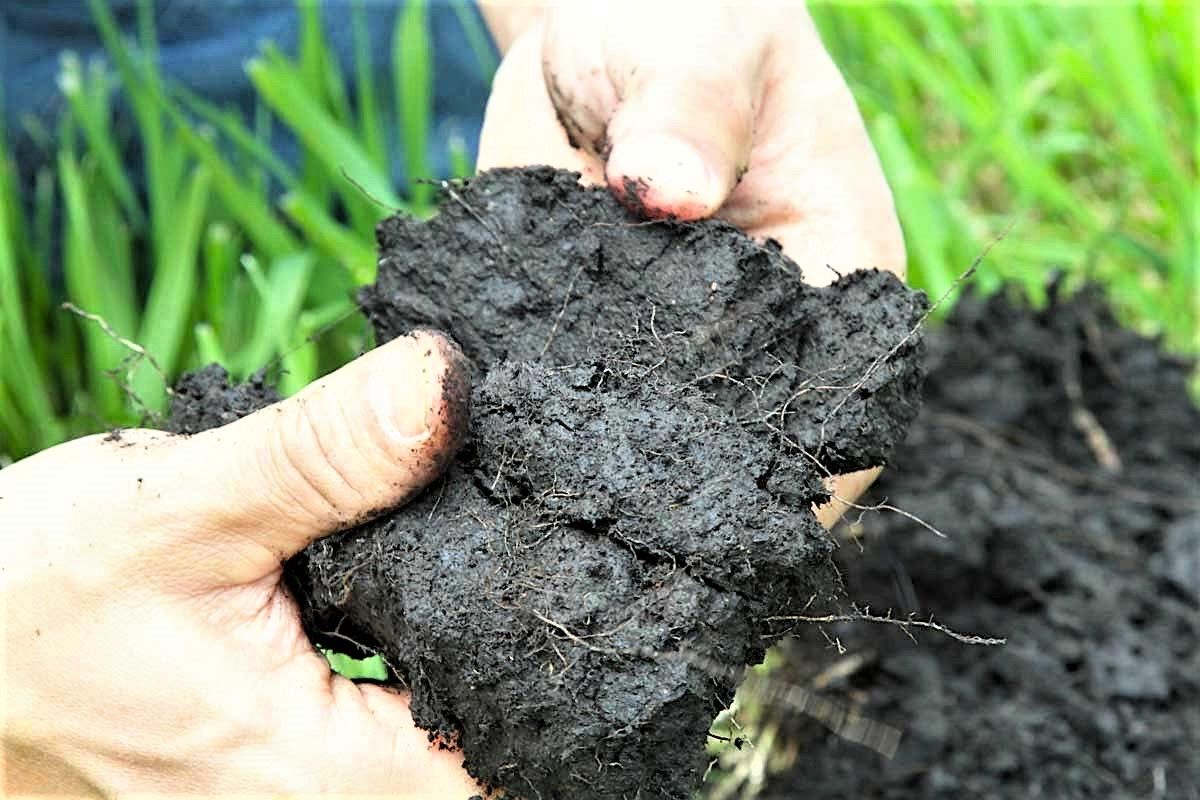
The grass roots spread through the soil like capillaries. Shinmura reevaluated his dairy farming from the soil up. (Courtesy of Shinmura Hirotaka)
Naturally, Shinmura had tried special pasture fertilizer from JA, the main domestic agricultural cooperative, and commercial companies, but they were all uniform packages composed of nitrogen, phosphorous, and potassium, and so do not reflect variations in soil quality. Using them would result in temporary grass growth but did not help improve the ecosystem within the soil, and over time could actually reduce productivity.
The soil class around Shinmura’s farm is moist volcanic soil. This tends to be calcium poor, and if it also sits within Hokkaidō’s unique peatlands it is usually deficient in phosphorous due to its tendency to fix phosphoric acids. From the start, much of Hokkaidō’s soil is what is called tokushu dojō, or “problem soil.” This refers to three types of poor soil that interfere in improving crop yields: heavy clay, volcanic soil (with volcanic ash), and peat soil. You could say that the history of Hokkaidō has been built on constant improvements made to overcome this handicap.
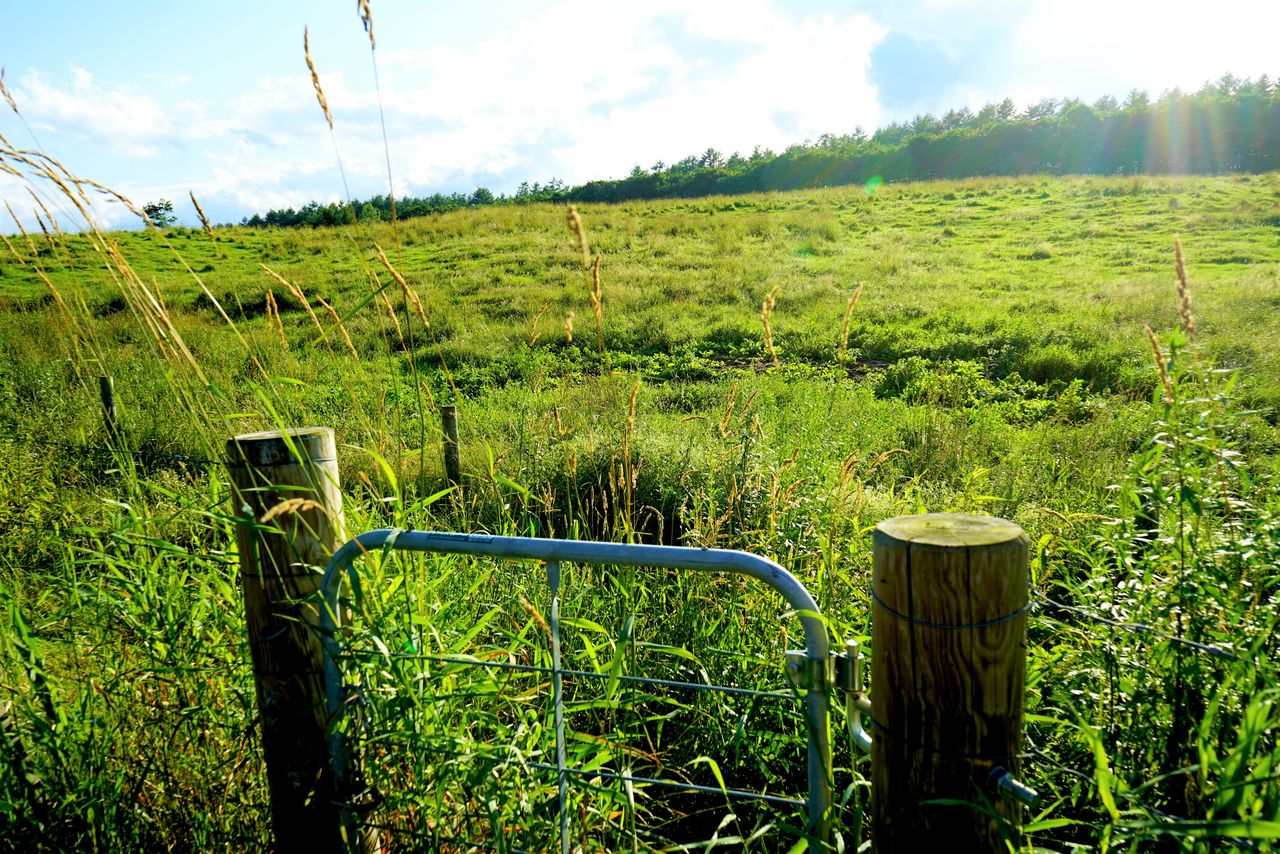
A pasture with grazing cattle. Shinmura selected the grasses for his pastures based on advice from Eric Kawabe. (© Ukita Yasuyuki)
Shinmura’s efforts are clearly reflected in the quality of his farm’s milk. Pasturage has also had the financial benefit of reducing the expense of buying feed. He says it has had another surprising benefit: “Enclosures require someone to look after the cattle around the clock, but letting the cattle roam means they look after themselves, so there’s less workload on people.”
In one example he offers, cows that suddenly start giving less milk soon seek out grasses high in fiber rather than those richer in nutritional value. This is a clear indication that the animals themselves manage their own health.
The extra time resulting from reduced workloads has let Shinmura expand into so-called “sixth industrialization” business based on processed products. He has built a cafe and shop on the farm, and his milk jam dairy product has become a wildly popular item on sale at over 1,000 shops across Japan. He has also started raising pigs and is selling processed food like sausages.
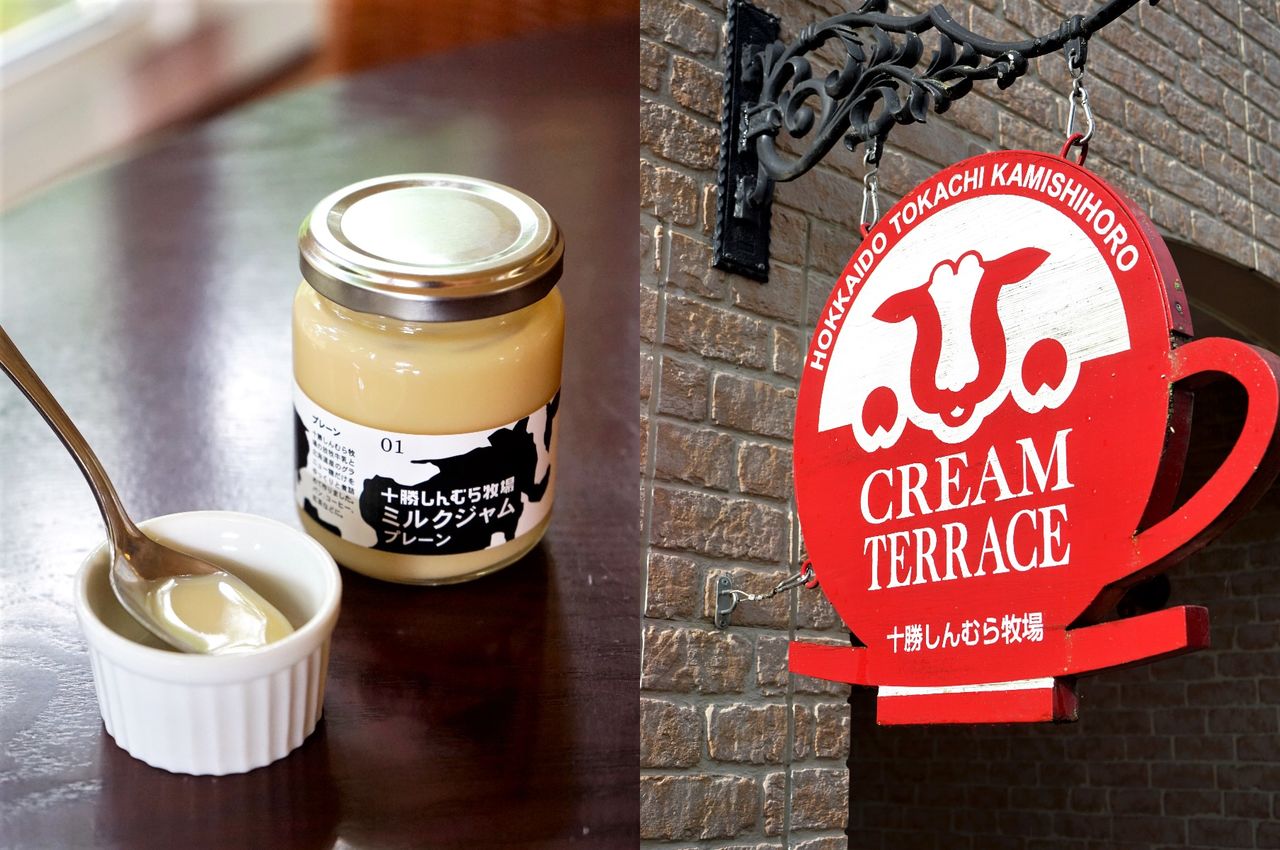
Left: Shinmura started working on milk jam from 2000. He chose a product with less competition than butter or yogurt. Right: The signage for the farm’s cafe and shop. (© Ukita Yasuyuki)
He is also making his way into the farm tourism business with a lodge with views of the sweeping pasture lands. The farm’s Milk Sauna, meanwhile, has an incredible view and has been rated one of the top saunas in Hokkaidō.
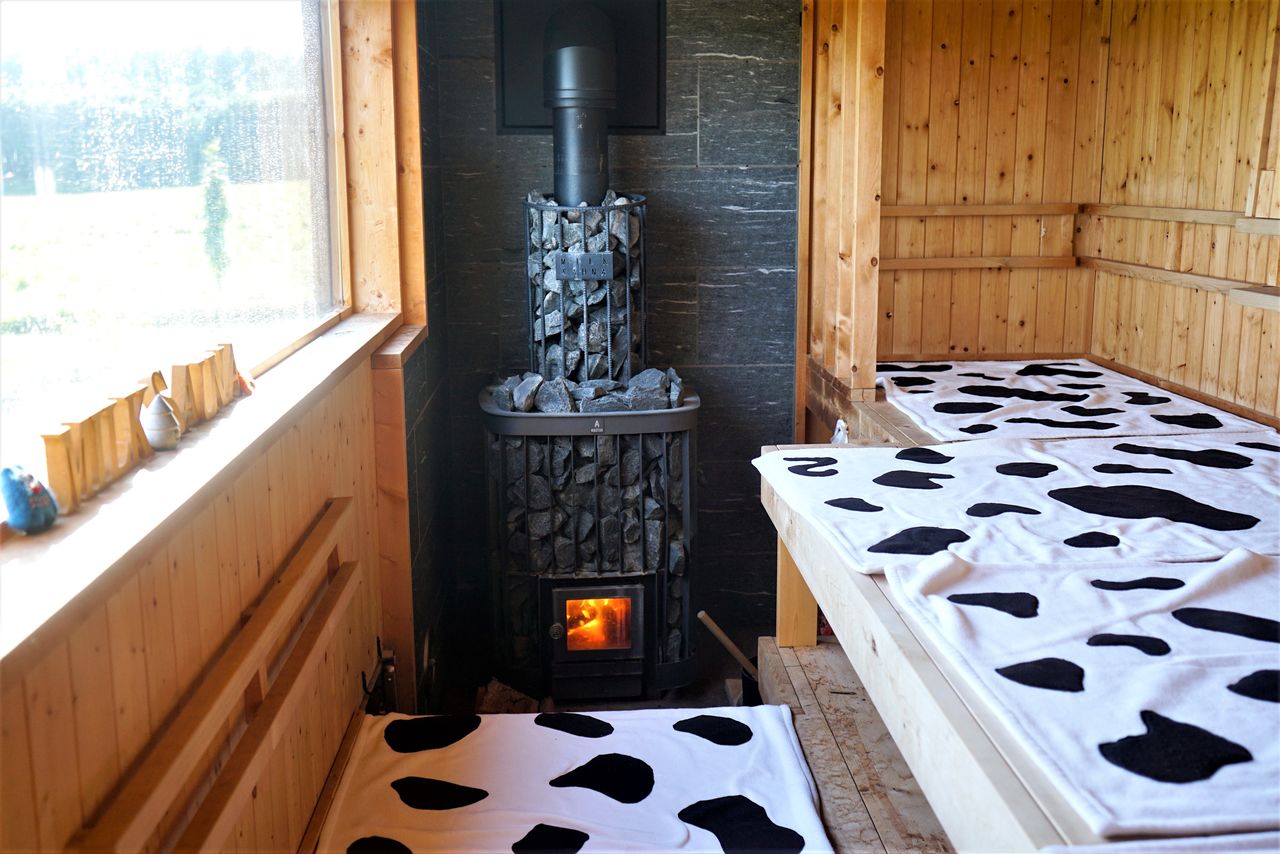
The farm’s pride and joy Milk Sauna with a view only found in Hokkaidō. Note that, naturally, no actual milk is used in the sauna. (© Ukita Yasuyuki)
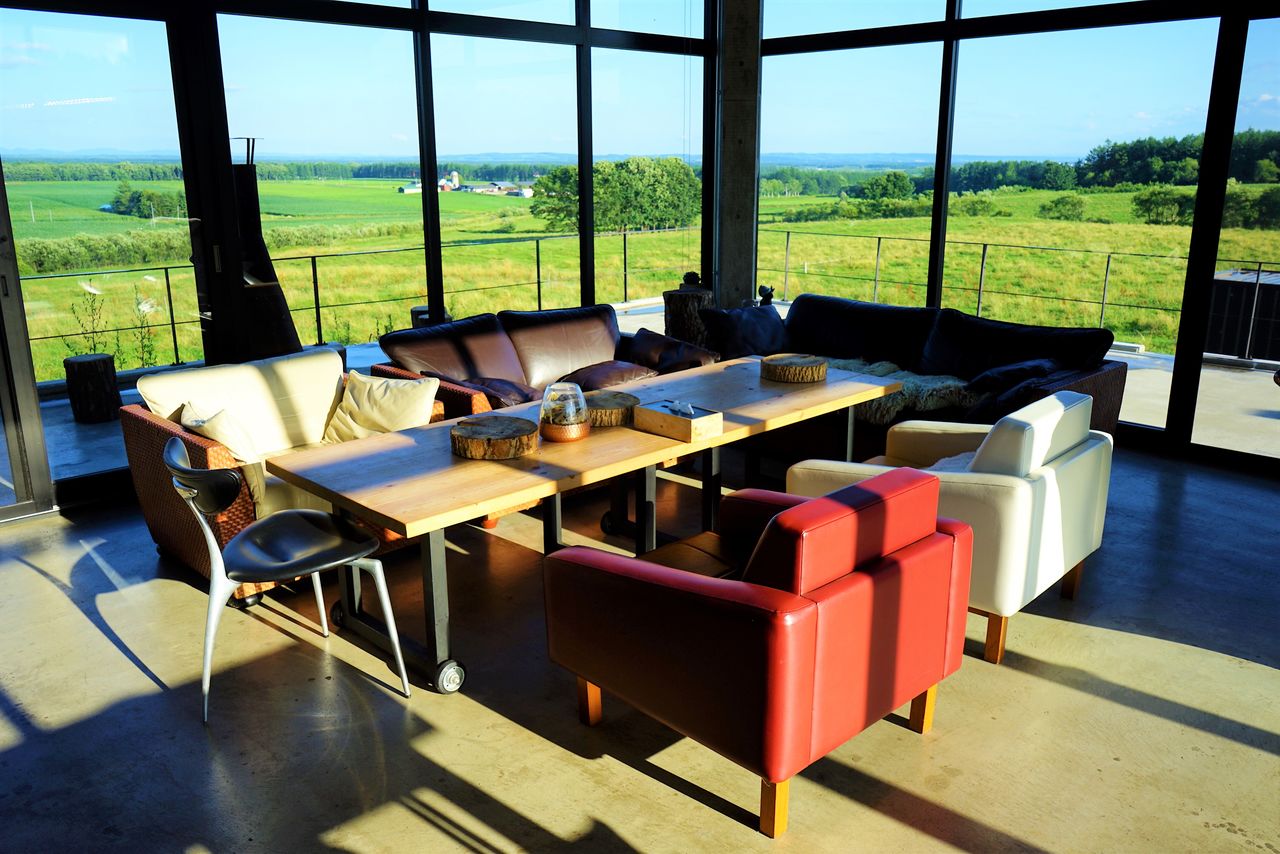
The view from the lodge sweeps over the pastures. There is a spot on the roof for stargazing at night. (© Ukita Yasuyuki)
Visitng Mongolia with a Former Yokozuna
Shinmura met Harumafuji Kōhei (born Davaanyamyn Byambadorj), a former sumō yokozuna (grand champion), through an introduction from a local architect and sumō fan.
Harumafuji was thinking about getting into dairy farming back home in Mongolia, and visited Hokkaidō to see how the business was done in a similar climate. Tokachi Shinmura Farm was one of the about 40 farms he toured and caught his eye in particular. He ended up visiting three times, saying that he wanted to run his own farm the same way as Shinmura.
Even before he retired from sumō in November 2017, he went back to Mongolia to share the experience and education he had gained in Japan with residents there, for example by building the Shine Mongol Harumafuji School.
With its long history of nomadic lifestyle, milk in Mongolia is considered a sacred thing much like omiki—a sake used in Shintō rituals—in Japan, but dairy farming there has a surprisingly low sustainability rate and the dairy quality is quite bad. Harumafuji felt it strange that children in his own country were so reluctant to drink milk, but when he tried the local milk himself, he says he almost fell into despair.
“I want the children of Mongolia to drink the same delicious, healthy milk that I had in Japan,” he said. That desire is what made him want to start a dairy farm.
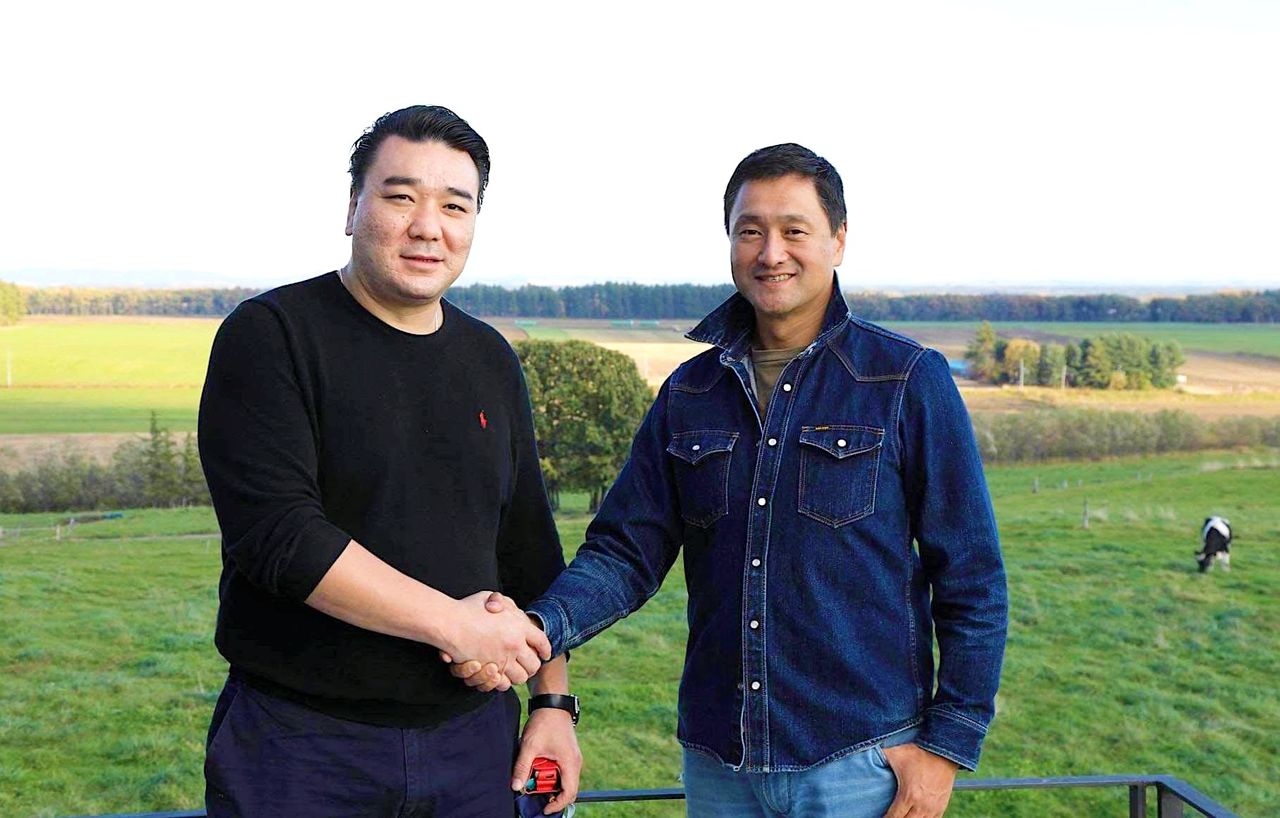
Harumafuji, at left, with Shinmura at the farm. (Courtesy of Shinmura Hirotaka)
Harumafuji invited Shinmura to Mongolia as a consultant in September 2022, where he went to see the planned farm location.
“I tried the local milk, but it was unbelievably bad. When I smelled it, I immediately thought something was wrong. The Mongolian grasslands were lifeless. When I analyzed the soil, it was basically dead, with very little microorganic life or organic matter. I thought that the only way to restore it to life would be to gradually improve the soil while adding compost.”
Shinmura took the Mongolian staff in hand for two months of training. Harumafuji himself also came to stay in Hokkaidō for a few days in January 2023 to learn the workflow. Since then, he has sometimes come with questions and to ask Shinmura for advice.
Harumafuji has imported a breed of cow from France called Montbéliarde, which is good for both meat and dairy, and his farm buildings are scheduled for completion in autumn this year. The first people to enjoy the milk from his farm will be the students of Shine Mongol Harumafuji School.
The Search for Sustainability
Now, Shinmura is working on adding the same Montbéliarde breed to his own farm. They can thrive on grass alone, while his current main breed of Holstein have been bred over the years for increased productivity, and so need a certain amount of grain in their diet as well.
“In five or ten years, I want to have more cows eating only grass, and focus on grass-fed milk.”
He is dependent on imports for the grain feed his Holsteins need, but the Russian invasion of Ukraine has caused grain prices to rise, which is in turn putting Japan’s dairy business in peril. Bringing in the Montbéliardes is another step toward sustainability.
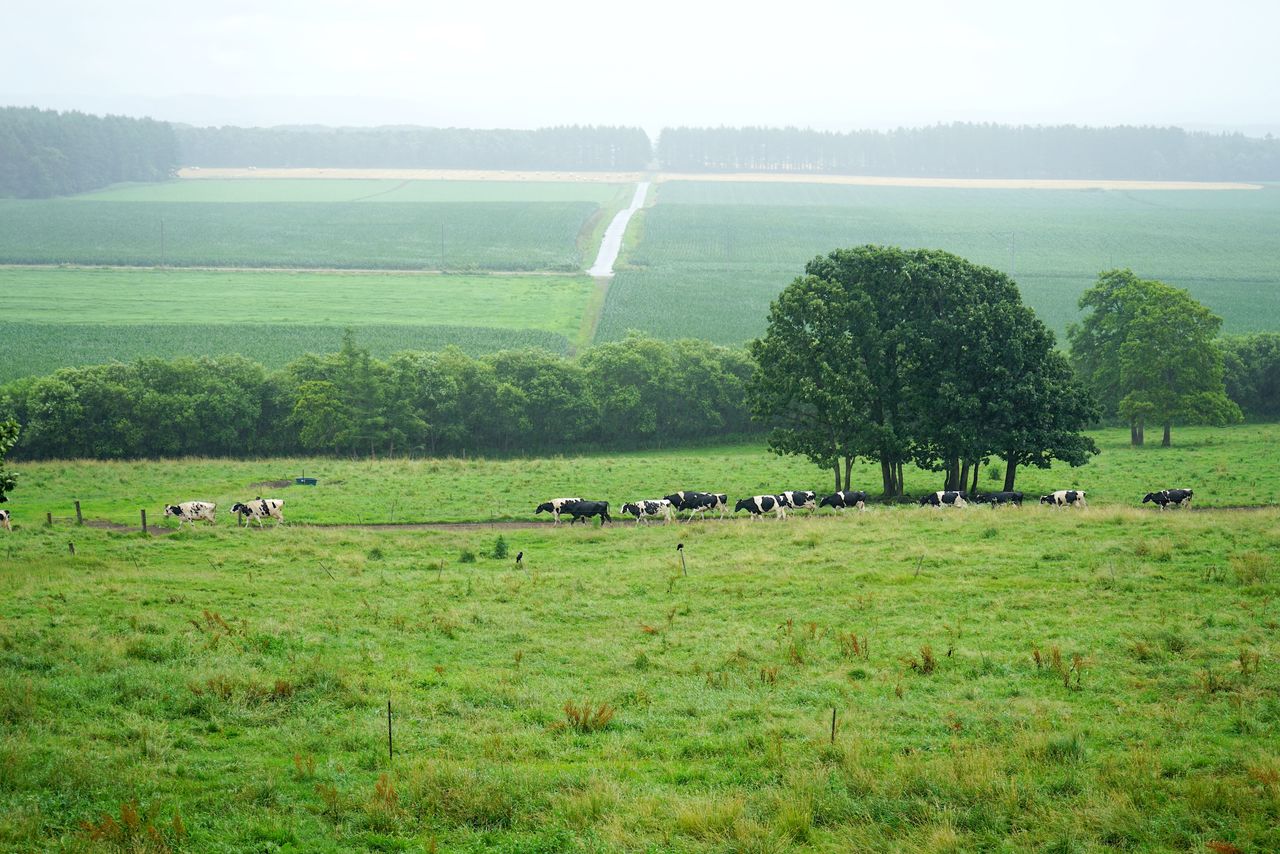
The cows take themselves into the milking barn. (© Ukita Yasuyuki)
At around 3:00 in the afternoon one day, I witnessed the cows on the farm forming a long line as they headed in from the pasture to the milking barn, all by themselves. They seem to be living contented lives, as is evident from their peaceful expressions and the leisurely pace at which they go about their day.
“There are some people who are dairy farmers because they just like cows, but not me. I think of cows as my business partners, in the end, and I think it’s natural to want these cows who work alongside us to be healthy and happy.”
While the words may sound somewhat cold and practical, I found them to reflect the way that Shinmura approaches business: with a proper balance between the profit motive on one hand, and respect for and ethical treatment of living things on the other.
(Originally published in Japanese. Banner photo: Cows grazing without a care. Tokachi Shinmura Farm has 130 head of cattle, as well as pigs, sheep, and horses. © Ukita Yasuyuki.)
"tasty" - Google News
October 29, 2023 at 10:00PM
https://ift.tt/TXZRDS2
It's All in the Soil: Tasty Free-Range Milk at Tokachi Shinmura Farm - Nippon.com
"tasty" - Google News
https://ift.tt/ansHTDO
https://ift.tt/Cng4IsY
Bagikan Berita Ini














0 Response to "It's All in the Soil: Tasty Free-Range Milk at Tokachi Shinmura Farm - Nippon.com"
Post a Comment